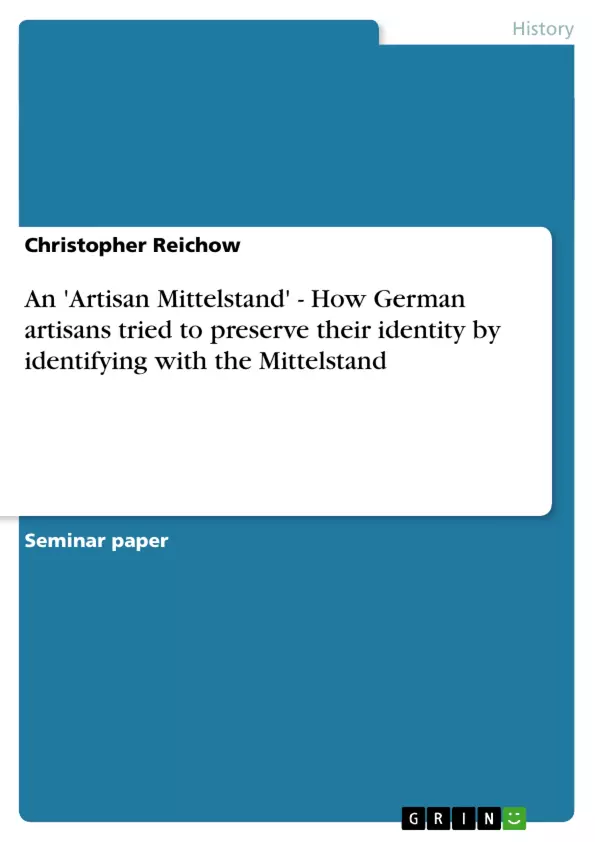Germany’s handicrafts and their institutional legacy highly influenced the social-economic development of their country. Their knowledge, know-how, and skills were important factors for Germany’s advancement to an economic powerhouse in the late nineteenth-century. But despite economic successes, an “anti-modern” attitude toward the new capitalist industry and its adherent working-class emerged during the last third of the nineteenth-century among the German artisans. This paper will show that the affiliation as well as the opposition of the German artisans toward other social and economic groups expressed a specific identity, both in social and economic terms. The core of the analysis will lay on the second half of the nine-teenth century and especially on the time period between the unification of Germany in 1871 and its short period of economic boom (Gründerzeit) and the end of the Great Depression in 1897. A subjective focus will reveal politically expressed differences in terms of values and preferences to the rising new economic order. Furthermore, it will be shown that the emerging working-class and their growing bond with journeymen compelled the economically prosper-ous artisans to reconsider their economic position within the German economy. Their redefinition as the Mittelstand was the answer to this development.
Inhaltsverzeichnis (Table of Contents)
- An “Artisan Mittelstand”: How German artisans tried to preserve identity by identifying with the Mittelstand
- Introduction: The German Artisan as a Counterpart to the New Working Class
- Artisans as a Diverse Group
- Class and the Artisan’s Identity
- The Great Depression: A Crisis for the Artisans
- Artisans as a Counterpart to the New Working Class: From Guilds to Liberalism
- The Artisan and the Middle Class
- From Honor to Proletarianization: The Degraded Artisan and the Decline of Identity
Zielsetzung und Themenschwerpunkte (Objectives and Key Themes)
This paper examines the evolving identity of German artisans during the late 19th century, focusing on their response to the rise of industrial capitalism and the growing working class. It investigates how the artisans, facing economic challenges and a changing social landscape, redefined themselves within the framework of the “Mittelstand” (middle class).
- The changing economic and social landscape in Germany during the late 19th century
- The impact of industrialization and the rise of the working class on the artisan's position and identity
- The artisan’s self-conception and the role of honor and status in shaping their identity
- The evolving relationship between artisans and the “Mittelstand”
- The role of education and technical innovation in shaping the artisan's identity
Zusammenfassung der Kapitel (Chapter Summaries)
- Introduction: The German Artisan as a Counterpart to the New Working Class: This chapter provides an overview of the German artisan's position in the late 19th century, highlighting their economic success and their complex relationship with the emerging working class. It sets the stage for the paper by outlining the key themes and arguments to be explored.
- Artisans as a Diverse Group: This chapter delves into the diverse nature of the artisan community in Germany, recognizing regional and sectoral variations in their economic experiences and social positions. It emphasizes the importance of understanding artisans as a group with distinct identities and interests.
- Class and the Artisan’s Identity: This chapter explores the concept of class in relation to the artisan's identity. It discusses how the artisan's economic interests and social consciousness were intertwined and how their class identity shifted in response to social and economic changes.
- The Great Depression: A Crisis for the Artisans: This chapter examines the impact of the Great Depression of 1873-1896 on the artisan community. It explores how the economic crisis intensified the tensions between artisans and the new working class, forcing them to reconsider their economic position.
- Artisans as a Counterpart to the New Working Class: From Guilds to Liberalism: This chapter analyzes the transition from a guild-based system to a more liberal economic order and its implications for the artisan's identity. It highlights the role of industrialization and the changing power dynamics in reshaping the artisan's status and self-conception.
- The Artisan and the Middle Class: This chapter focuses on the evolving relationship between artisans and the “Mittelstand.” It examines how the artisans, confronted with economic pressures and social changes, increasingly identified with the middle class, seeking both economic and social security.
- From Honor to Proletarianization: The Degraded Artisan and the Decline of Identity: This chapter explores the changing meaning of work and the decline of artisanal identity. It examines how the artisan's honor and status were challenged by industrialization, and how the "degraded" artisan, forced to adapt to mass production, faced a loss of traditional skills and a diminished sense of self-worth.
Schlüsselwörter (Keywords)
This paper explores the complex themes of artisan identity, industrialization, class formation, and the role of the “Mittelstand” in shaping German society during the late 19th century. It examines the artisan's response to economic changes, their evolving self-conception, and the cultural and social factors that influenced their sense of belonging. Key terms and concepts include: German artisans, industrialization, working class, “Mittelstand,” honor, status, proletarianization, guild system, liberalism, and craft consciousness.
- Quote paper
- Bachelor of Arts Christopher Reichow (Author), 2011, An 'Artisan Mittelstand' - How German artisans tried to preserve their identity by identifying with the Mittelstand, Munich, GRIN Verlag, https://www.grin.com/document/179618



